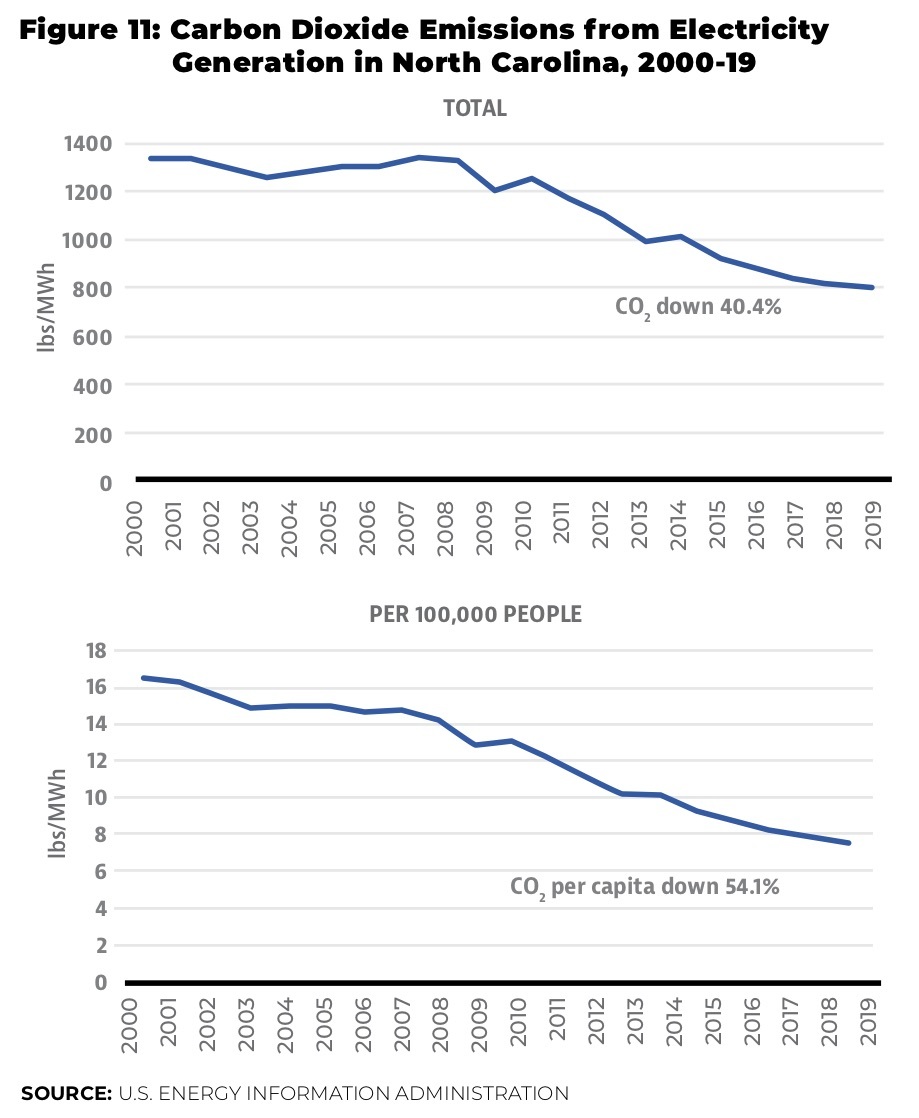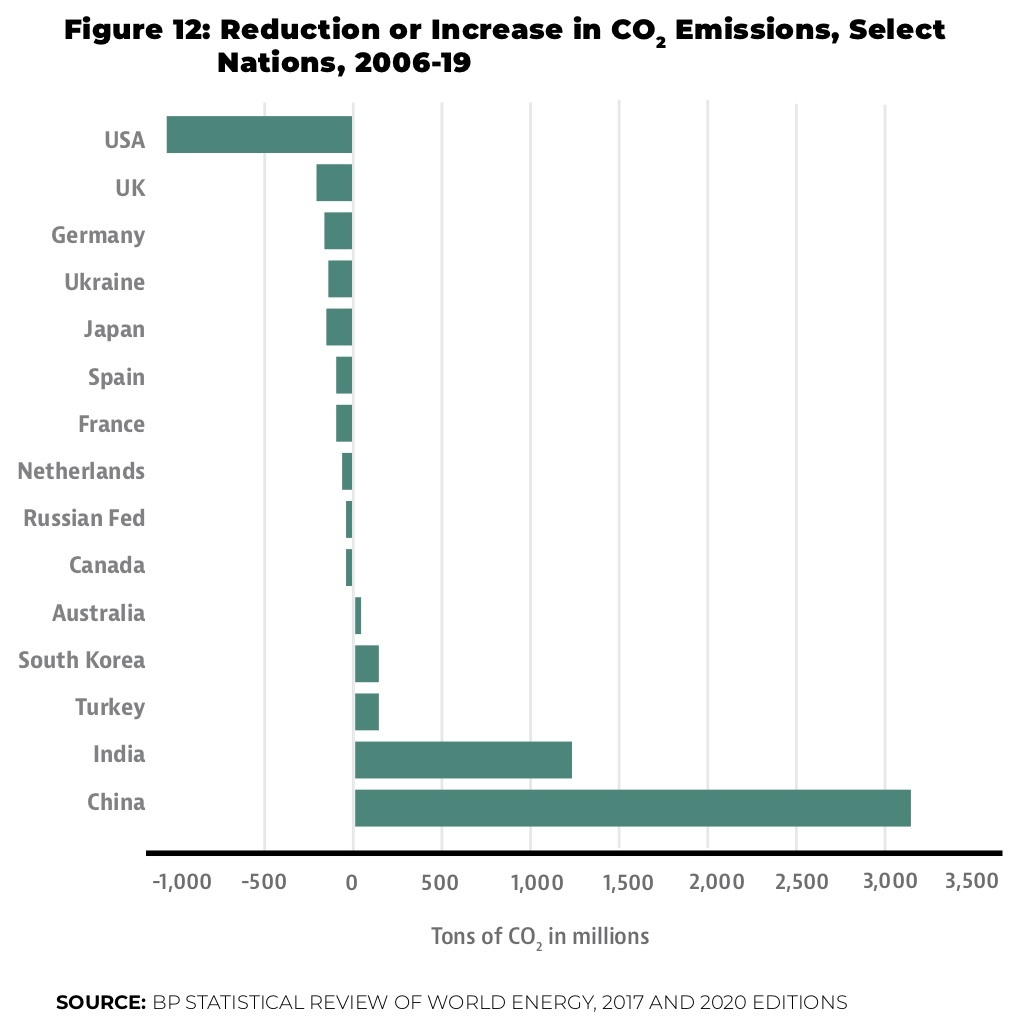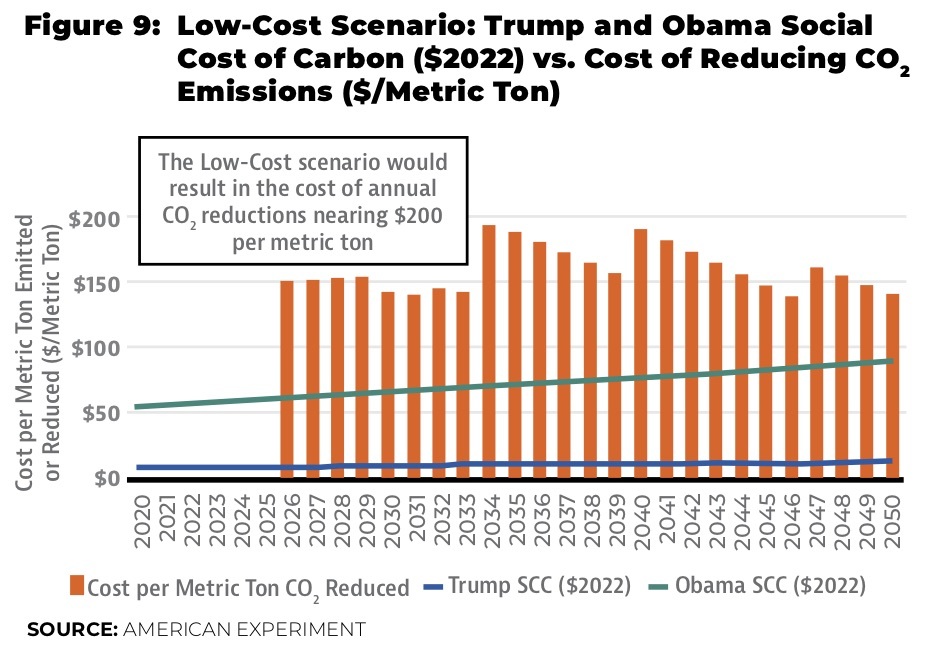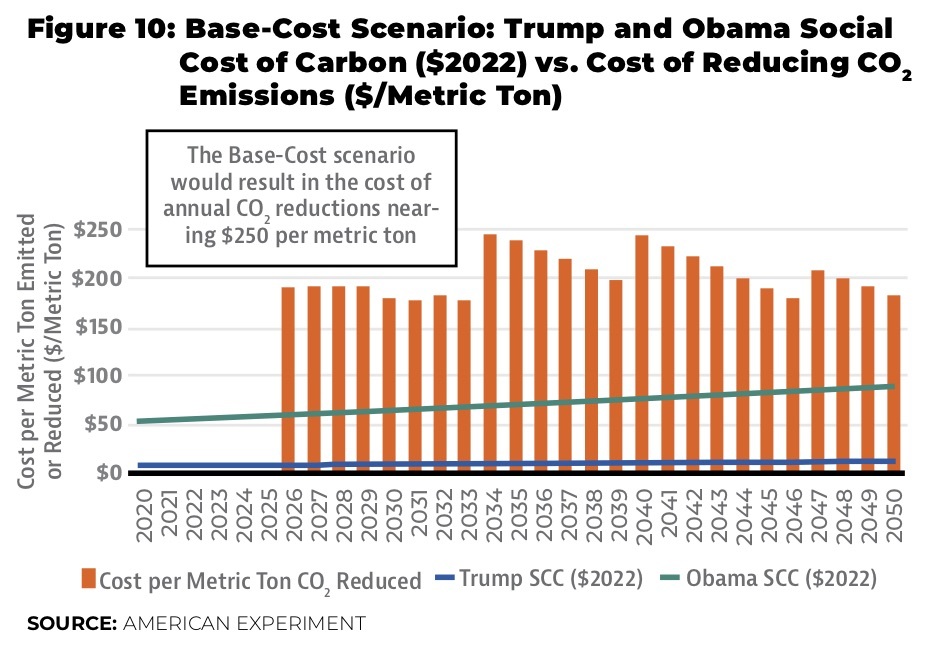- North Carolina has been cutting CO2 emissions this whole century without costly offshore wind energy being forced on electricity consumers
- Meanwhile, China has added 38.4 GW of new coal-fired electricity in 2020, announced 43 new coal-fired power plants and 18 new blast furnace projects in 2021, and said it will increase coal output by 300 million tons this year
- New emissions from China and India this year will erase all of the emissions cut by the U.S. (let alone N.C.) in the past 15 years
The previous research brief discussed the impossibility of North Carolina being able to affect the world’s climate not just by reducing our CO2 emissions, but even by ceasing all emissions entirely. Pres. Joe Biden’s “Special Presidential Envoy for Climate,” John Kerry, had made a similar observation, looking beyond North Carolina to the entire United States of America:
Even if every single American biked to work or carpooled to school or used only solar panels to power their homes – if we reduced our emissions to zero, if we planted each of us in America a dozen trees, if we somehow eliminated all of our domestic greenhouse gas emissions, guess what? That still wouldn’t be enough to counteract the carbon pollution coming from China and the rest of the world.
Regardless, Gov. Roy Cooper seeks — at great expense to North Carolinians — the construction of 8 gigawatts (GW) of offshore wind capacity near North Carolina beaches. As shown in a new study from the Center for Food, Power, and Life at the John Locke Foundation, “Big Blow: Offshore Wind Power’s Devastating Costs and Impacts on North Carolina,” building and maintaining 8 GW of offshore wind here would destroy jobs, hike electricity bills, worsen energy poverty, harm the coastal fishing and tourism industries, and cause unknown and mostly unstudied harms against endangered and critical marine and avian creatures and habitats. Nevertheless, one of the reasons for Cooper’s order is to reduce North Carolina’s CO2 emissions, thinking it would help fight climate change.
This brief will elaborate on the issue of China and others’ emissions as well as examine the costs of Cooper’s desire for 8 GW of offshore wind near North Carolina beaches even using the questionable “Social Cost of Carbon” metrics.
Ongoing CO2 reductions in North Carolina without offshore wind
Throughout the 21st century, CO2 emissions from electricity generation in North Carolina have been falling dramatically. Just since 2000, CO2 emissions from electricity generation in North Carolina had fallen 40.4% by 2019. Since this decline coincided with rapid population growth, it means that CO2 emissions per capita had fallen by 54.1%. (See Figure 11 from the report.)
Note: Data concluding in 2019 are more indicative of trends since 2020 is likely to be an outlier in (lower) CO2emissions owing to disruptions caused by Covid-19 and government orders in response to it.

Falling emissions in N.C. and the U.S. being obliterated by increased emissions in China, elsewhere
The problem identified by Kerry in 2014 is worsening. According to the BP Statistical Review of World Energy, between 2006 (when the index began tracking CO2 emissions) and 2019 (pre-Covid), the United States had eliminated far more CO2 emissions than any other nation, reducing its CO2 emissions by 1,064.5 million tons. Meanwhile, China’s CO2emissions increased by 3,164.2 million tons, almost triple the amount cut by the U.S. By implication, North Carolina’s gains in reducing emissions — a commensurate part of the U.S.’s overall emissions reductions — are being quickly wiped out by China’s emissions increases. (See Figure 12 from the report.)
Note: Again, the pandemic year 2020 was an outlier in world energy usage. Of interest, though, is that the BP Statistical Review of World Energy 2021 showed that energy-based CO2 emissions declined in 2020 for nearly every nation, but China’s still increased.
Notably, China continues to build new, high-emissions coal-fired power plants, suggesting their rate of increase in CO2 and other emissions will not decline but even accelerate in the coming years. A briefing from the Centre for Research on Energy and Clean Air in August 2021 reported that in just the first half of 2021, China had announced 43 new coal-fired power plants and 18 new blast furnace projects, which combined would emit an estimated 150 million tons of CO2 per year. Those are in addition to the 38.4 GW of new coal-fired electricity China added in 2020.

The reality is that any additional emissions reductions in North Carolina (i.e., beyond what would already happen) that could be achieved by government orders would be erased by Chinese emissions increases in very short order, to say nothing of increases in India, Turkey, and elsewhere. The “Big Blow” report estimated that adding 8 GW of new offshore wind would result in a reduction of 11.9 million metric tons of CO2 per year. At that rate it would take nearly 27 years just to offset the additional CO2 added by China in the year 2019 above its output the previous year.
Meanwhile, of course, China and many other nations will still be adding more CO2. Robert Bryce noted for RealClear Energy very recently (June 26) of additional fallout from the global energy crisis:
Indeed, all around the world, countries are turning back to coal to produce power and the resulting emissions from increasing coal use will obliterate all of the emissions reductions that have been achieved in the United States over the past decade and a half.
Here are the numbers. In April, China announced it will increase coal output by 300 million tons this year. In May, India said it aims to increase domestic coal production by more than 400 million tons by the end of next year. According to the Energy Information Administration, burning a ton of coal releases about 2 tons of carbon dioxide. Thus, the 700 million tons per year of new coal consumption in China and India will result in an additional 1.4 billion tons of carbon dioxide emissions. According to BP, that’s about the same volume of emission reductions that were achieved in the U.S. between 2005 and 2020.
Projected cost of CO2 reductions would far outweigh questionable “Social Cost of Carbon” gains
According to the report, North Carolina would see total CO2 emissions reductions estimated at 345 million metric tons compared to 2020 levels. This would be an average CO2 emissions reduction of 11.9 million metric tons per year through 2050. The average cost of reducing CO2 emissions would be $162 per metric ton reduced through 2050 in the report’s Low-Cost scenario and $207 per metric ton reduced in the Base-Cost scenario. Either way, those are very high costs.
They’re so high, in fact, they would even outstrip the cost estimates under the questionable “Social Cost of Carbon” (SCC) approach of monetizing the costs of CO2 emissions according to the differing SCC values estimated by both the Obama and Trump administrations. The SCC is an attempt to attach a dollar amount to supposed economic damage caused by CO₂ emissions. Note: A federal judge has placed a preliminary injunction against Pres. Biden’s reinstatement of the Obama administration’s SCC level.
In fact, the cost of CO2 reductions resulting from building offshore wind facilities exceeds SCC estimates from both administrations every single year (see Figures 9 and 10 from the report).


In 2034, the cost per metric ton of CO2 reduced is $194 for the Low-Cost scenario and $246 for the Base-Cost scenario. Those are 178% and 254% more expensive than Obama’s SCC ($70), respectively, and 1,835% and 2,364% more expensive than Trump’s SCC ($10), respectively.
Conclusion
The simple fact of the matter is that North Carolina cannot cut enough CO2 to offset what China already added, let alone what China and the rest of the world is adding now. The danger to North Carolinians is state leaders inflicting costly, damaging policies against us in the naïve belief we can.


